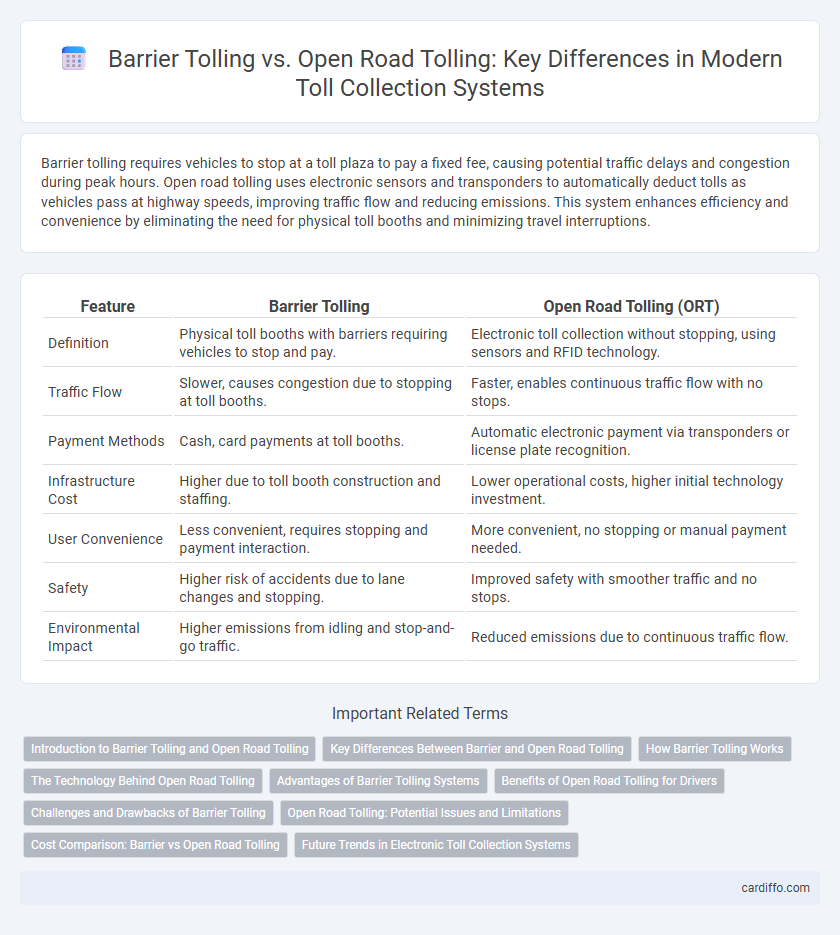Barrier tolling requires vehicles to stop at a toll plaza to pay a fixed fee, causing potential traffic delays and congestion during peak hours. Open road tolling uses electronic sensors and transponders to automatically deduct tolls as vehicles pass at highway speeds, improving traffic flow and reducing emissions. This system enhances efficiency and convenience by eliminating the need for physical toll booths and minimizing travel interruptions.
Table of Comparison
| Feature | Barrier Tolling | Open Road Tolling (ORT) |
|---|---|---|
| Definition | Physical toll booths with barriers requiring vehicles to stop and pay. | Electronic toll collection without stopping, using sensors and RFID technology. |
| Traffic Flow | Slower, causes congestion due to stopping at toll booths. | Faster, enables continuous traffic flow with no stops. |
| Payment Methods | Cash, card payments at toll booths. | Automatic electronic payment via transponders or license plate recognition. |
| Infrastructure Cost | Higher due to toll booth construction and staffing. | Lower operational costs, higher initial technology investment. |
| User Convenience | Less convenient, requires stopping and payment interaction. | More convenient, no stopping or manual payment needed. |
| Safety | Higher risk of accidents due to lane changes and stopping. | Improved safety with smoother traffic and no stops. |
| Environmental Impact | Higher emissions from idling and stop-and-go traffic. | Reduced emissions due to continuous traffic flow. |
Introduction to Barrier Tolling and Open Road Tolling
Barrier tolling involves physical toll booths where vehicles stop or slow down to pay tolls, typically used on highways with designated toll plazas. Open Road Tolling (ORT) employs electronic systems that allow continuous traffic flow without stopping, using cameras and transponders to automatically collect tolls at highway speeds. ORT enhances traffic efficiency and reduces congestion compared to traditional barrier tolling methods.
Key Differences Between Barrier and Open Road Tolling
Barrier tolling requires vehicles to stop at physical toll booths to pay fees, causing traffic delays and congestion, whereas open road tolling uses electronic systems to collect tolls at highway speeds without stopping. Barrier tolling depends on manual or automated payment methods at designated points, while open road tolling utilizes RFID transponders and cameras to charge tolls seamlessly through overhead gantries. Open road tolling enhances traffic flow efficiency and reduces emissions by eliminating the need for toll plazas found in barrier tolling systems.
How Barrier Tolling Works
Barrier tolling operates by collecting toll fees at fixed locations where vehicles must stop or slow down to pay. Toll plazas equipped with barriers enforce payment either manually by toll booth operators or automatically through electronic systems like RFID tags. This method controls traffic flow at designated points but may cause congestion during peak hours due to vehicle stoppage.
The Technology Behind Open Road Tolling
Open Road Tolling (ORT) leverages advanced technologies such as RFID transponders, automatic number plate recognition (ANPR), and dedicated short-range communications (DSRC) to facilitate seamless vehicle identification without requiring stops. These systems integrate with centralized toll management software to enable real-time data processing, payment verification, and traffic monitoring. The elimination of physical barriers enhances traffic flow efficiency and reduces congestion compared to traditional barrier tolling methods.
Advantages of Barrier Tolling Systems
Barrier tolling systems offer precise revenue collection by requiring all vehicles to stop at designated points, minimizing toll evasion compared to open road tolling. These systems provide reliable control over traffic flow and enable consistent enforcement using physical barriers. Maintenance and technological upgrades tend to be simpler and less costly, enhancing long-term operational efficiency.
Benefits of Open Road Tolling for Drivers
Open Road Tolling (ORT) offers drivers significant time savings by eliminating the need to stop at toll booths, allowing seamless and continuous travel. ORT reduces congestion and traffic bottlenecks, enhancing fuel efficiency and cutting vehicle emissions. This electronic toll collection system also improves safety by minimizing sudden stops and accidents commonly associated with traditional barrier tolling.
Challenges and Drawbacks of Barrier Tolling
Barrier tolling faces challenges such as traffic congestion caused by physical toll booths, leading to increased travel times and vehicle emissions. High operational and maintenance costs arise from the need for human toll collectors and infrastructure upkeep. Limited scalability and susceptibility to toll evasion further reduce efficiency compared to open road tolling systems.
Open Road Tolling: Potential Issues and Limitations
Open Road Tolling (ORT) eliminates physical toll booths, enabling vehicles to pass at highway speeds, which reduces congestion but introduces challenges such as increased risk of missed tolls due to vehicle misidentification and reliance on electronic transponders or license plate recognition. Data accuracy issues and the need for robust enforcement mechanisms can lead to revenue losses and disputes with drivers. Privacy concerns also arise from continuous vehicle tracking and data collection inherent in ORT systems.
Cost Comparison: Barrier vs Open Road Tolling
Barrier tolling requires substantial infrastructure investment including toll booths, barriers, and staffing, leading to higher operational and maintenance costs. Open road tolling utilizes electronic systems with lower physical infrastructure demands, significantly reducing ongoing expenses and improving toll collection efficiency. Long-term cost analysis shows open road tolling offers better scalability and cost savings compared to traditional barrier tolling systems.
Future Trends in Electronic Toll Collection Systems
Future trends in electronic toll collection systems emphasize the transition from barrier tolling to sophisticated open road tolling technologies, enhancing traffic flow and reducing congestion. Open road tolling leverages advanced sensor networks, artificial intelligence, and satellite-based GPS tracking to enable seamless, cashless toll payments without the need for physical toll booths. Innovations in vehicle-to-infrastructure communication and blockchain security protocols are expected to drive greater efficiency, transparency, and scalability in toll collection systems worldwide.
Barrier Tolling vs Open Road Tolling Infographic

 cardiffo.com
cardiffo.com